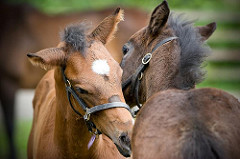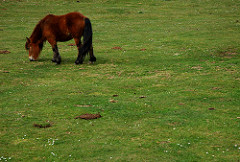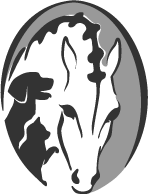Wobbler Disease
 What exactly is Wobbler disease? If you are a horse owner, you may be quite familiar with the disease. Did you know, however, that Wobbler disease is no stranger to canines? Let’s take a deeper look.
What exactly is Wobbler disease? If you are a horse owner, you may be quite familiar with the disease. Did you know, however, that Wobbler disease is no stranger to canines? Let’s take a deeper look.
What is Wobbler Syndrome?
Wobbler is essentially a narrowing of spinal canal or space in between adjacent vertebrae of the cervical spine thus putting abnormal pressure upon the spinal cord and nerves. This pressure can lead to very obvious neurological problems, causing the animal to “wobble” when moving. The gait appears unsteady and confused; the front legs will often float as the animal hesitates in placing them down.
Causes of Wobbler
It can develop in a couple of different way. Firstly, disc issues such as herniations or bulges can lead to Wobbler in canines. Secondly, bony malformation of the spinal canal can be a big contributor. Any condition that narrows the normal structure surrounding the spinal cord and the nerve roots can then cause compression.
Who’s Most Commonly Affected?

Giant breed dogs tend to be the victims. Great Danes, Mastiffs, Rotts, Shepherds, Mountain Dogs, Dobermans, and Wolfhounds tend to be the breeds of interest. Some breeds experience the condition closer to 6 or 7 while others happen before 3.
In the equine world, horses that grow incredibly fast and have abnormalities in their extremities tend to be predisposed to Wobbler’s syndrome. Also horses with unusual and imbalanced forces being placed upon the appendicular skeleton are more likely to experience the disease. As far as a more in depth genetic connection, one has not definitively been linked at this time, however the research continues to grow.
Symptoms
In horses, symptoms include ataxia, spasticity, weakness in the hind end, and sometimes involvement of the forelimbs. It’s usually noticed during riding or walking the horse and can be seen when the horse trips frequently, drags his or her toes, and a general instability. The stance is often wide and the legs float when they walk. Neck pain is moderate to severe.
 As previously mentioned, canines will tend to hesitate and “float” their forelimbs while walking and the hind will wobble back and forth. Neck pain is moderate with associated muscle spasm to guard the cervical spine. The pup can have a great deal of trouble getting up and down, experience partial limb paralysis, muscle atrophy, and scuffed or broken nails from toe dragging while walking. Animals with Wobbler’s tend to hang their heads quite low and will roach the mid to lower back while walking. Though a cervical spine disease, symptoms often begin in the back end and slowly progresses to the forelimbs.
As previously mentioned, canines will tend to hesitate and “float” their forelimbs while walking and the hind will wobble back and forth. Neck pain is moderate with associated muscle spasm to guard the cervical spine. The pup can have a great deal of trouble getting up and down, experience partial limb paralysis, muscle atrophy, and scuffed or broken nails from toe dragging while walking. Animals with Wobbler’s tend to hang their heads quite low and will roach the mid to lower back while walking. Though a cervical spine disease, symptoms often begin in the back end and slowly progresses to the forelimbs.
Diagnosis & Management
 MRI is the gold standard for diagnosing Wobbler. There are multiple options including radiographs and myelograms, but MRI is the most definitive. When diagnosed, Wobbler can be managed through surgery, medicine, and/or alternative therapies. Surgery of the cervical spine can be done to reduce pressure on the spinal cord. Most of these animals will require greatly decreased activity levels and a harness rather than a collar around the neck. Medications can be used to target inflammation and swelling, but is not a permanent solution. Alternative therapies include hydrotherapy, acupuncture, physical therapy, Chinese medicine, and chiropractic are all ways to help manage Wobblers non-invasively.
MRI is the gold standard for diagnosing Wobbler. There are multiple options including radiographs and myelograms, but MRI is the most definitive. When diagnosed, Wobbler can be managed through surgery, medicine, and/or alternative therapies. Surgery of the cervical spine can be done to reduce pressure on the spinal cord. Most of these animals will require greatly decreased activity levels and a harness rather than a collar around the neck. Medications can be used to target inflammation and swelling, but is not a permanent solution. Alternative therapies include hydrotherapy, acupuncture, physical therapy, Chinese medicine, and chiropractic are all ways to help manage Wobblers non-invasively.
Prevention
The best way to help your giant breed dog is going to be preventative action. Joint supplements, chiropractic care, exercise to maintain muscle tone and strength, in addition to using harnesses are all great ways to help protect your animal and decrease their risk for Wobbler’s disease.
With horses, prevention is not as simple as with canines. Much of what is seen in Wobblers in the equine world is based upon growth patterns, something that cannot necessarily be changed. Massage, chiropractic and other alternative therapies can help horses diagnosed with Wobbler, though surgery is often what is recommended.
Sources:
http://healthypets.mercola.com/sites/healthypets/archive/2012/02/13/wobbler-syndrome.aspx
http://www.rossdales.com/downloads/rossart5_cvsm_wobblers.pdf?i=236
Photo credits:
DSC_8188 via photopin (license)
63008-23 via photopin (license)
Green, brown, horse. via photopin (license)
Rupert the Bulldog via photopin (license)
Tara Oct 2012 (1 of 8) via photopin (license)
Dogs heavywheight … via photopin (license)




Leave a Reply
Want to join the discussion?Feel free to contribute!